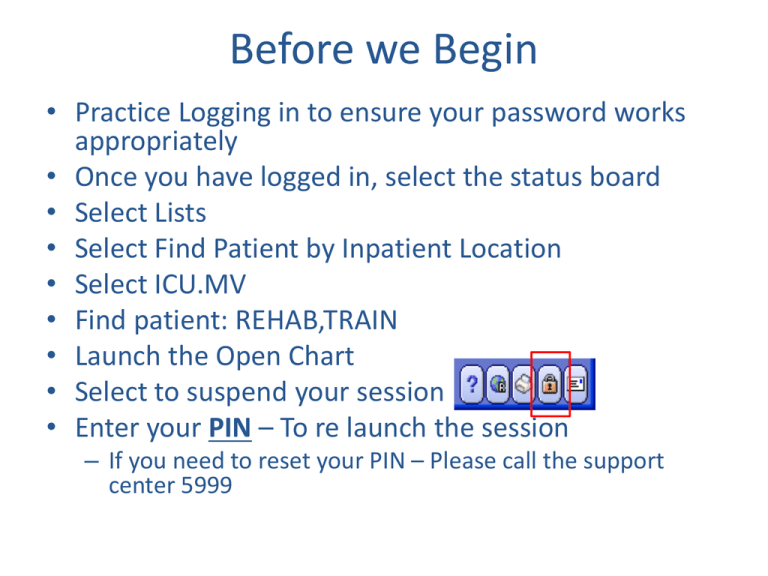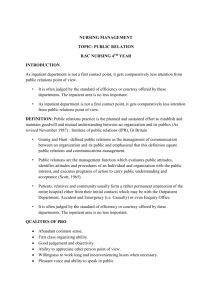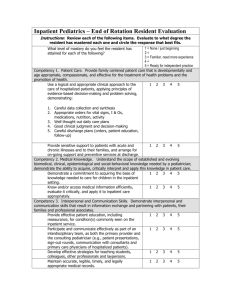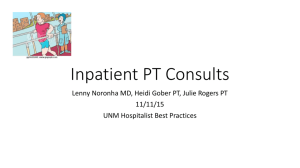PT Inpatient Set
advertisement

Before we Begin • Practice Logging in to ensure your password works appropriately • Once you have logged in, select the status board • Select Lists • Select Find Patient by Inpatient Location • Select ICU.MV • Find patient: REHAB,TRAIN • Launch the Open Chart • Select to suspend your session • Enter your PIN – To re launch the session – If you need to reset your PIN – Please call the support center 5999 Meditech 6.0 Upgrade Rehab Session I Acronyms • PCS: Patient Care System – Intervention and Outcome Documentation – Notes • EMR: Electronic Medical Record – Review clinical documentation • OM: Order Management – Enter Orders Agenda • PCS: Patient Care Systems – Overview – Status Board – Worklist – Care Planning – Documentation Functions • EMR: Electronic Medical Record – Reviewing patient information Rehab Main Menu • List of Routines and Reports • PCS Status Board will provide most nursing care routines Rehab Main Menu A • Physician Care Manager – View Patient Information - EMR • PCS Status Board – Patient Care Desktop (Contains several patient care applications) – Inpatient or ED Worklist Documentation – Assessments/Interventions/Outcomes – View Patient Information - EMR • EDM Tracker – Patient Care Desktop (Contains several patient care applications) – ED Patient Documentation - Assessments/Interventions • Admissions - Reports – Bed Roster – Discharge Register Rehab Main Menu • Reconciliation Menu – Therapists Desktop – Charge Entry – Reconciliation Reports – Billing Reports • Imaging and Therapeutic Services – Management Routines and Reports • Print Operating List – Report Routine: OR, PAT, Day Surgery Schedules • Provider Look-Up – Routine to Look Up Physician Contact Information PCS: Patient Care Systems Status Board PCS Status Board Patient Assignment List Status Board Function Buttons • • Patient Assignment List/Home Page Displays Pertinent Patient Information – Relevant to the particular patient location • • • Patient Care Routines & Function Buttons ie: Psych, MedSurg, Rehab, etc Continuously Refreshes with new information (every 5 minutes) Launching pad to various patient care routines My List • Manually Add Patients to your list – Pts are Retained From One Log-on to the Next • Discharged Patients Remain on your Status Board until manually removed – Enables Care Provider to Complete Documentation even after the patient has left the facility • Manually Remove Patient from your List – Once you have Completed your Documentation and the patient has been discharged (or you are leaving for the day) • The more patients on your List the longer the status board will take to load Adding Patients to your List • [Lists] Button provides options to search for and add patients to your List – Find Account • Search for single patient by patient name – Find Patient by Inpatient Location • Provides a list of patients admitted to each location • Provides the ability to add multiple patients to your list at one time – My List • Launches your patient assignment list Video Demonstration II PCS Status Board PCS Status Board Exercise A: Find Patient by Account 1. Click [Lists] 2. Click [Find Account] 3. Type Patient’s Name (Last Name, First Name) – Use assinged REHAB,TRAIN patient 4. Click to the select the patient account – Select the Account Number with the Admin In Registration Type – The status Board will Appear • • • • Click [Add to My List] – Footer Button Click [Lists] Select [My List] Confirm this new patient has been added to your List Exercise B: Find Patient by Location 1. 2. 3. 4. 5. 6. 7. 8. 9. Click [Lists] Click [Find Patient by Inpatient Location] Select [Test ICU.MV Location] Click [Assignments] - Right hand panel Place a checkmark to the left of a couple of patient names Click [Add to My List] -Footer Button Click [Lists] - Right hand panel Select [My List] Confirm that both patients have been added to your assignment list Open Chart Open Chart • All Inclusive Patient Care Routine – Review Patient Data – Complete Assessment Documentation – Enter Orders Open Chart • EMR Electronic Medical Record – Review Patient Data • OM Order Management EMR – Review Orders • PCS Patient Care System – Worklist • Intervention/Assessment Documentation – Write Note • Clinical Data • View Allergies • View Home Medications • Enter/Review Patient information OM PCS Open Chart: Patient Header Location, Room, Bed Age, Sex DOB Allergies Height/Weight/BSA Admit Status Medical Record Number Account Number Worklist Worklist Worklist Open Chart Routines Worklist Functions • • Open Chart defaults to the worklist tab Documentation Routine – • • Interventions, Assessments, & Outcomes Worklist is shared by all Care Providers Care Items display based upon Care Provider Type – – – PT Assessments display for Physical Therapist OT Assessment Display for Occupational Therapists SLP Assessments Displays for Speech Language Pathologists Worklist: Standard of Care – Upon registration a Standard of Care Automatically defaults • Vital Signs will display for Rehab automatically – For the first encounter, you will add an intervention set before you begin documenting – To Add an Intervention or Intervention set, click the Add Button Rehab Intervention Sets • Group of Interventions/Assessments • Added based upon services provided • Each set will provide the basic interventions needed for all patients • Additional interventions/assessments can be added as needed Rehab Intervention Sets: Physical Therapy • PT Inpatient Set – PT Inpatient Evaluation – PT Inpatient Visit Note – GRP PT/OT Therapeutic Exercises – GRP Balance Assessment – GRP ROM Assessments – GRP Gross Muscle Strength • PT Inpatient Orthopedic Set – PT Inpatient Evaluation – PT Inpatient Visit Note – GRP PT/OT Therapeutic Exercises – GRP Balance Assessment – GRP ROM Assessments – GRP Gross Muscle Strength – Same as above Plus CPM Rehab Intervention Sets: Occupational Therapy • OT Inpatient Set – OT Inpatient Evaluation – OT Inpatient Visit Note – GRP PT/OT Therapeutic Exercises – GRP Balance Assessments – GRP ROM Assessments Rehab Intervention Sets: SLP • SLP Inpatient Set – SLP Speech - Language Evaluation – SLP Inpatient Visit Note • SLP Inpatient Set – SLP Bedside Swallow Evaluation – SLP Inpatient Visit Note Adding a New Intervention Set • Intervention Sets or Individual Interventions may be added to the worklist • Additional Interventions may be added as needed • To add new intervention or set use the [Add] button Add Intervention Set Routine • The Quickest Method of searching for an Intervention is by [Any Word] – Searches the entire intervention name • Click [Any Word] and type the intervention name you wish to add Add Intervention Set Routine • Type the name of the intervention set and click enter • Select the Intervention from the List and click save Exercise: Adding a New Intervention Set • From the Status Board Launch the patient’s open chart by placing a checkmark to the left of the patient’s name • From the Worklist, click [add] • Select Intervention Sets • Enter PT, OT, or SLP (Based on your provider type) • Select one of the following – PT Inpatient Set – OT Inpatient Set – SLP Inpatient Set • Click Ok • Confirm that the Interventions display as expected Exercise: Adding a New Intervention • • • • Use the same patient From the Worklist, click [add] Select Interventions Select one of the following – Sensation Assessment – Stair Climbing assessment – SLP Voice Eval • Select the assessment • Click Save • Confirm that the Interventions display as expected Individual Interventions • • • • • • • • • • • • • • Tendon Reflex Assessment Sensation Assessment Ambulation Assessment Gait Pattern Assessment Postural Screen Assessment Stair Climbing Assessment Lymphedema Assessment Extremity Circumference Assessment Neural Tension Assessment SLP Modified Barium Swallow SLP Voice Eval SLP Fluency Eval SLP Bedside Swallow Eval SLP Laryngectomy Eval Worklist • Interventions/Assessments will display on the worklist to be documented • The worklist is clickable and sortable • Click any of the worklist headers to sort the list Documentation Overview Documentation Overview • Documentation mode defaults to flowsheet – Provides a view of prior documentation – Mode Button will toggle to Questionnaire mode • Similar to a paper assessment Documentation - Flowsheet White Column = Documentation Mode Gray Background = View Mode Recall is Enabled for PMH Current Date/Time Defaults Documentation - Questionnaire • Clicking Mode will toggle to Questionnaire Style • You may toggle between Questionnaire and Flowsheet mode at any time within documentation Video Demonstration IV Documentation Documentation Exercise D: Documenting Inpatient Eval 1. Start from the worklist 2. Place a checkmark in the now column for the Inpatient Evaluation 3. Click [Document] – Confirm the time column displays the current date/time in the header – Review the documentation • Displaying from the last admission 4. 5. 6. 7. Click [Mode] to toggle to Questionnaire Mode Document the first Patient Profile Section and click save Click [Save] Confirm the last done column updates with the last time the intervention was documented EMR Patient Care Panel • Displays PCS Documentation – – – – Assessments Interventions Outcome Care Plan Exercise E: Reviewing Documentation - EMR • • • • • • • • • Click [Patient Care Panel] Confirm that the [Assessment] Tab Defaults Select to view the Inpatient Evaluation Documentation Place a Checkmark to the left of the Assessment Name Click [View History] Confirm that documentation displays Click [Back] Click [Plan of Care] Tab – Header Click the [+] Symbol (in the description header) to Expand the Components of the Care Plan • Review the Care Plan Components Break 1 Hour 30 Minutes (15 Minute Break) Documentation Frequencies • • • • • Assessments and Interventions for the patient display on the worklist Frequencies vary based upon protocol and physician orders Frequency column indicates how often to document Last done column indicates the last time the assessment was documented Frequencies can be edited as needed based upon a particular Order or Protocol Documentation Functions Documentation – Instance Type – Enables multiple instances of documentation for various body locations, positions or situations • PT Treatment Goals – Click the New PT Short Term Goal text – Enter free text Documentation – Instance Type • Document the fields for the situation/instance • Repeat the instance type documentation for the new Short Term Goal Documentation – Back Time • To back date/time your documentation, click the drop down arrow in the header • Adjust the date/time to reflect when the data was collected Documentation – Expand/Collapse • Clicking the [-] symbol will collapse the field within the section Documentation – Collapse • Notice the temperature section is now collapsed • You may now click the [+] symbol to expand • Some sections will default as collapsed – Notice the Thermal Management Documentation defaults this way and can be expanded as needed • Documentation that is infrequently utilized will default as collapsed and must be manually expanded as needed • The Manual Expand/Collapse will stick for the current assessment only Exercise F Part A: Documentation Functions - Back Documenting • • • • • Select the [worklist] routine Select Inpatient Visit Note Click in the now column for the Inpatient Visit Note Click [Document] Back Document 1 Hour in the Past – In the Header, click the drop down to the right of the Date/Time Field – Change the time to 1 hour in the past • Document • Save Exercise H: Review Documentation in EMR • Select [Patient Care Panel] in the EMR • Place a checkmark to the left of the Inpatient Visit Note • Click View History • Confirm that the Inpatient Visit Notes displays under the adjusted time (1 hour in the past) • Click [Back] Recall Values Recall Values • Recall Values provides the ability to pull prior documentation to the current assessment • This function is enabled for a select number of assessments • To invoke the recall values function, click the [Recall] Button Recall Values Recalls the entire assessment Recalls the section Recalls the individual query • Assessment displays in green • A column of diamonds appear to the right • Select the diamonds to recall individual queries, entire sections, or the whole assessment • It is critical that you review the recalled information to ensure accuracy before saving • Recalling & saving = Signing your name to the documentation Exercise I: Recall Values • Use the first TEST Patient on your Blue Card • Document Inpatient Visit Note – Click in the now column to select the Inpatient Eval intervention – Click Document – Click Recall – Notice the screen turns green and diamonds appear in the right hand column – Click to recall one query: select to the right of the pertinent medical history – Click to recall the entire assessment: select to the right of the Inpatient Eval • Confirm the entire assessment has recalled – Review all documentation to ensure accuracy – Click Save Care Plan Rehab Problems/Goal/Plan • Short Term Goals, Long Term Goals, and Treatment Plans are established in the Inpatient Evaluation Exercise: Documenting Patient Goals and Rehab Treatment Plan 1. 2. 3. 4. 5. Document the inpatient evaluation Place a checkmark in the now column Click Document Click Mode to toggle to questionnaire mode Scroll to the bottom of the assessment and find the PT Treatment Goals 6. Indicate two short term goals 1. Click new short term goal to start an instance and free text the first goal 1. Document the assessment Exercise: Documenting Patient Goals and Rehab Treatment Plan 1. Click new short term goal to start an second instance and free text the second goal 1. Document the assessment 2. Create a new instance for a long term goal 3. Document the patients treatment plan Review the Goals in the Rehab Summary Panel • Click Clinical Panels • Select Rehab Summary Panel • Confirm that the Rehab Long Term Goals, Short Term Goals, and Recommendations display Open Practice Session • Practice Documenting – Assessment Review • • PT Inpatient Set – PT Inpatient Evaluation – PT Inpatient Visit Note – GRP PT/OT Therapeutic Exercises – GRP Balance Assessment – GRP ROM Assessments – GRP Gross Muscle Strength PT Inpatient Orthopedic Set – PT Inpatient Evaluation – PT Inpatient Visit Note – GRP PT/OT Therapeutic Exercises – GRP Balance Assessment – GRP ROM Assessments – GRP Gross Muscle Strength – Same as above Plus CPM • OT Inpatient Set – OT Inpatient Evaluation – OT Inpatient Visit Note – GRP PT/OT Therapeutic Exercises – GRP Balance Assessments – GRP ROM Assessments OM/EMR Training Agenda • • • • • • • Introduction to the EMR Allergies, Code Status Non-Med Order and Order Set Entry Consults and Uncollected Specimens Acknowledgment and Incomplete Orders Post-Filing Edits to Orders Entering Requisitions Intro to EMR • Electronic Medical Record • Integrated system so same information is viewable regardless of point of entry or desktop • Central access point for all results, patient demographic information, reports, clinical documentation, and clinical data. Intro to EMR •Selected tabs represent the EMR, viewable from all desktops with shared information •Patient header includes name, age, DOB, ht, wt, MRN, Acct number, Reg status, location/room/bed, and allergies •Items that have information “new to you” will be highlighted in red. “i”: More Information •Small “i” next to patient name provides additional information such as allergies, height, weight, admit date and time, BMI, and Code Status. Select Visits Panel •This panel allows you to select the visits for which you wish to view patient data. Choose a time period and visit type, or manually check off the visits you wish to view. Current visit is the default. Summary Panel •The summary panel holds clinical, demographic, and legal information regarding the patient. Allergies, home medications and problems (diagnoses) can be edited via the blue edit button. Allergies and home medications are usually edited on the Clinical Data screen which will be covered later. Summary Panel (cont) •The legal indicators page of the summary panel includes important patient information such as patient rights information, language, immunization, readmission data, blood type, precautions, fall risk, and Braden score. This information is also viewable for all visits by selecting the “all visits” tab. Review Visit •Review visit contains pertinent admission information including reason for visit and physicians associated to this patient visit. •The “More detail” footer button provides additional demographic and administrative information. •The patient abstract can be viewed and printed using the “Abstract” footer. Notices •The notices panel displays those notifications that have been sent to the physician desktop for acknowledgement. These include critical lab results, consultations, and certain nursing events such as patient falls. •The Send Notice button will allow users to manually queue this notice to another physicians desktop that may need to be aware of the result/event. New Results •The New Results panel shows new labs and reports that are new to you. They can be sorted to include data from the last 24 or 48 hours. Tests with multiple results will be listed in a separate date/time column. •All critical results in Meditech are shown highlighted in red/pink and abnormal results will always show in yellow. Clicking on the result will show additional information including the reference range for the test. Clinical Panels •Clinical panels are constructed to provide a comprehensive view of the patient by pulling various types of patient data onto one panel. Additional clinical panels can be found by selecting the “Panels” footer button. Displayed is the M/S Handoff panel. •Information is trended by date/time, but different time increments can be selected using the footer buttons. •You can also choose to pull in data from previous visits by selecting the Visits footer button. Vital Signs •Documented Vital Signs from the nursing assessment appear here. Additional documentations will be trended in an adjacent column by date/time. For patients with large amounts of documentation, the arrows at the top of the screen allow for scrolling through older documentation. I&O Documented intake and output will be listed here. Again data will be trended by date and time and can be adjusted to display increments of 1, 4, 8, 12, and 24 hours. Medications The default on the Medications tab, is the medication list which is a simple list of all medications during this patient’s visit, but can be expanded to include medications from all visits. Clicking the header of each column allows the list to be sorted accordingly. Additional filters can be applied using the footer buttons at the button. Medications cont The second tab on the Medications panel provides a view only display of the MAR. All information on the MAR can be viewed, but no documentation can take place here. You must visit the true MAR for this. The detail footer button allows for viewing of additional medication information, such as the flowsheet, monograph, medication detail, protocol/taper schedules, and any associated data. Laboratory The Laboratory Panel displays all lab data separated out by category. This defaults to the visits selected, but all visit data can be displayed by choosing that tab. Clicking the name of the test will launch you to a list of all results for that test. Clicking the result itself will launch you to a screen to view additional test data, such as the reference range. Laboratory cont Lab reports can be printed by clicking on the date and time header of the lab panel. The user will be launched to a collection data screen, where he/she can select lab report and print the data. Microbiology The Microbiology panel displays all microbiology tests that have been received into the lab. The status and results will be displayed with the procedure. Clicking on the notepad will launch the user out to the final report. Blood Bank The Blood Bank Panel allows for Blood related information to be tracked on the patients. The LAB/BBK department will update information in this panel along with the Blood Product Infusion Record/Reaction documentation done in nursing. Reports The reports panel shows all reports that have been entered on the patient, including radiology report, cardiology reports, dictated physician reports, physician documentation reports, as well as Allscripts reports once they are live in the system. *Initially Allscripts reports will be housed in the patient paper chart. Clicking the notepad will launch you to the report for viewing and printing. Patient Care The Patient Care tab provides a view only overview of all assessments and interventions documented on the patient. The plan of care is also viewable from here. The information can be sorted out by date, name, recorded by, and provider type. Patient Care cont Clicking onto the name of an assessment or intervention will launch you into a view only display of the documentation. No edits can be made from this panel. Notes The notes panel displays all notes entered on the patient by nursing, physicians, and other staff. Dictations and Physician Documentation reports (such as Progress Notes, H&P, Discharge Summary, etc) are not found here. They are on the reports panel. To view, either check off the box next to the desired note and click “View Selected” or clicking directly on the note. Orders Orders will be discussed in detail later in the training. For purposes of the EMR, however, the orders panel is accessible to all users on any desktop. All active orders will be displayed on the current orders table and the history panel contains these as well as cancelled, completed, and discontinued orders. EMR • Electronic Medical Record (EMR) Exercise M: EMR • Use: MTPatient,TEST • Where are two places in the EMR that I can find documented allergies on a patient (Hint: Clinical data is NOT part of the EMR)? • Where can I view the last medication administration in the EMR (Hint: your nursing MAR is not part of the EMR) • How can I easily tell whether a lab is of abnormal or critical value? • If I want to see a trend in a patients vital signs, how would I accomplish this? EMR Hands-On • Use MTPatient,Test • What is the easiest and most succinct way to locate a patients standard of care and individualized plan of care? • It is the end of your shift and you are preparing to hand off your patient, where would be the best place to find a comprehensive overview of that patient for that shift? • On the day of go live, where should you go to find all scripts reports?



